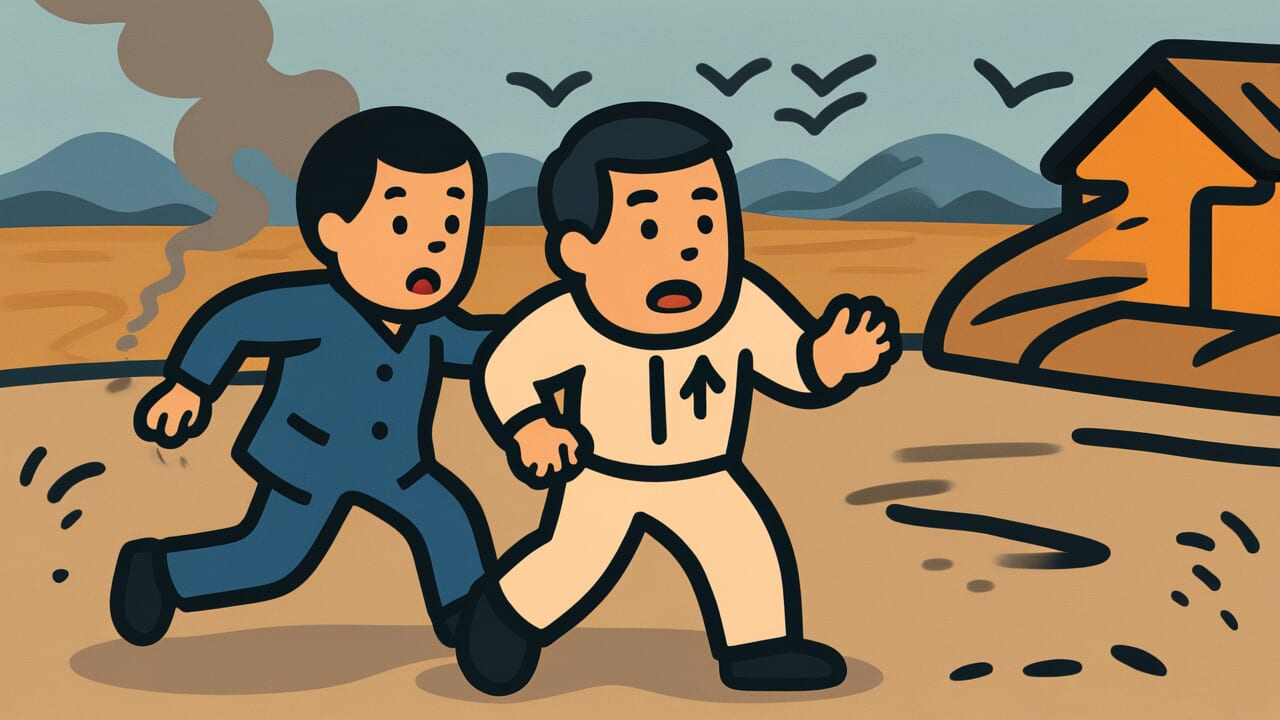How to Read “When one disaster strikes, two disasters strike”
Issai okoreba nisai okoru
Meaning of “When one disaster strikes, two disasters strike”
“When one disaster strikes, two disasters strike” means that when one misfortune occurs, another one tends to follow.
It shows that disasters rarely happen alone. They tend to chain together one after another.
People use this proverb when unfortunate events keep happening. For example, you oversleep and are about to be late.
Then your train gets delayed, or you realize you forgot something important. People also use it to warn others that one problem might not be the end.
We still experience this phenomenon frequently today. When one problem occurs, we get anxious and flustered.
This clouds our judgment and leads to more mistakes. Sometimes one disaster physically or psychologically creates conditions for the next one.
This proverb teaches us to recognize how disasters chain together. It reminds us how important it is to handle the first disaster calmly.
Origin and Etymology
There are no clear records of when this proverb first appeared in literature. However, the structure suggests it comes from observations Japanese people accumulated over many generations.
The parallel structure using numbers like “one disaster” and “two disasters” is common in Japanese proverbs.
This structure effectively conveys the phenomenon of chaining disasters. Using specific numbers like first and second makes the abstract concept of “disasters continue” feel more real and tangible.
People have actually experienced disasters piling up since ancient times. In agricultural societies, prolonged drought would kill crops.
This would lead to famine, which would then spread disease. The pattern of one misfortune calling another became shared wisdom through lived experience.
This proverb contains not just observation but also warning. When one disaster strikes, prepare for the next.
It reflects the practical wisdom of ancestors. They knew that handling the first disaster well is crucial to breaking the chain.
Usage Examples
- I got sick and missed work, and that happened to be the day of an important meeting. When one disaster strikes, two disasters strike.
- I thought I lost my wallet, then I couldn’t find my phone either. It was exactly a case of when one disaster strikes, two disasters strike.
Universal Wisdom
“When one disaster strikes, two disasters strike” has been passed down for generations because it captures a deep truth about life.
The chaining of disasters is not mere coincidence. It is an inevitable flow created by the interaction between human psychology and circumstances.
When one disaster occurs, our minds become disturbed. Panic, anxiety, and fear cloud our judgment.
We make mistakes we normally wouldn’t make. When we lose our composure, we become more likely to take actions that invite the next disaster.
This is a human trait that doesn’t change with time.
Furthermore, one disaster physically creates the ground for the next. Economic loss triggers other problems.
Trouble in relationships generates new conflicts. Problems don’t exist in isolation. They have a nature of chaining together and amplifying each other.
However, this proverb is not simple pessimism. Rather, knowing the law of chaining disasters helps us prepare for it.
When the first disaster strikes, that’s when we should take a deep breath and regain composure.
Whether we can break the chain at that moment determines our fate afterward. Our ancestors knew human weakness.
Yet they passed down wisdom for overcoming that weakness.
When AI Hears This
Imagine an experiment where you drop sand grains one by one onto the top of a sand pile.
At first nothing happens, but eventually the pile reaches an unstable state called “criticality.”
In this state, a single grain might cause a small collapse, or it might trigger a massive avalanche involving the entire pile.
The key point is that the outcome isn’t determined by the size of the grain you dropped. It’s determined by the structure of the entire pile.
The chaining of disasters can be explained by the same principle. Our daily lives consist of multiple elements in delicate balance.
These include time, money, energy, and relationships. When one disaster occurs, this balance breaks and approaches criticality.
For example, oversleeping is a small disaster in itself. But it creates a chain: loss of trust from being late, judgment errors from rushing, and health problems from stress.
Because the entire system has become unstable, the probability of triggering the next disaster rises sharply.
Physicist Per Bak’s research showed that the scale of sand pile avalanches follows a “power law.”
Small collapses happen frequently, but large-scale collapses also inevitably occur at a certain probability.
The chaining of disasters is not coincidence. It is the inevitable behavior of a system in a critical state.
Lessons for Today
This proverb teaches modern people the essence of crisis management. When problems occur, we tend to focus only on the immediate disaster.
But what truly matters is looking ahead.
When one disaster strikes, treat it as a warning sign. Something in your life or work may have become unstable right now.
By looking at the root cause, you can prevent the next disaster.
Specifically, develop the habit of stopping and taking a deep breath when trouble occurs.
Acting in panic will only invite more mistakes. Staying calm is your greatest weapon for breaking the chain.
Also, when one problem occurs, make it a habit to check other related areas. Preventive action stops the second and third disasters.
This proverb is not a pessimistic prediction. It is wisdom to protect you.
Because we know the law of chaining disasters, we can prepare for it and overcome it.
Whether you end it at one disaster or let it chain depends on how you respond.



Comments